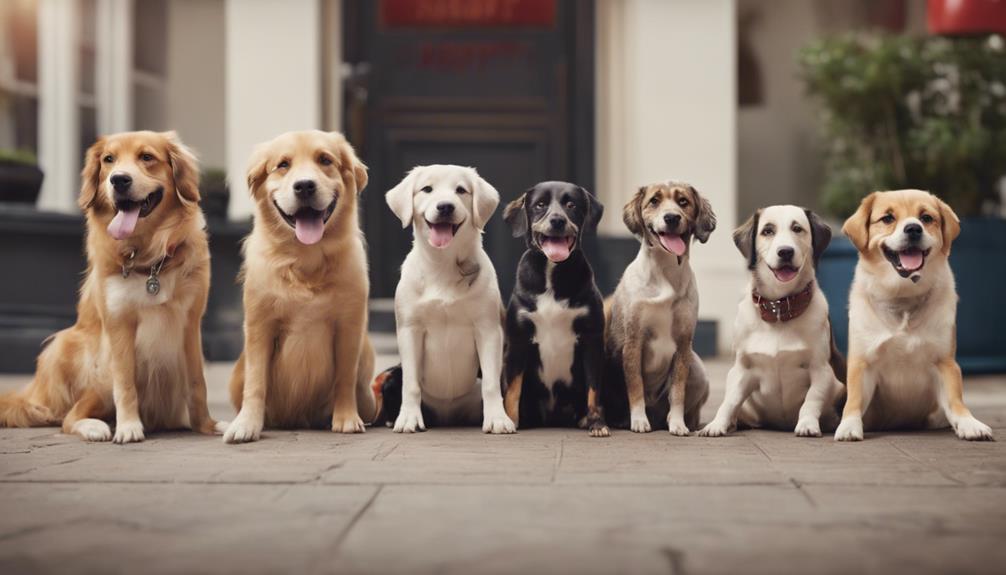Local Dog Adoption: Finding Dogs For Sale Near Me

Finding Dogs For Sale Near Me: As you casually stroll through your neighborhood, you might notice a flyer for adorable dogs for sale nearby. The idea of welcoming a furry friend into your home tugs at your heartstrings, but where do you start your search for the perfect canine companion? Well, before you make any decisions, it’s crucial to understand the importance of local dog adoption. The benefits go beyond just finding a pet; it’s about creating a lifelong bond and making a positive impact. So, how can you ensure you find the right match for your family? Let’s explore the world of local dog adoption and discover dogs for sale near you.
Benefits of Local Dog Adoption
When considering adopting a dog, choosing a local shelter or rescue organization can offer numerous benefits for both you and the animal. One significant advantage is the training benefits that come with adopting from a local shelter. Many of these shelters work with professional trainers to ensure that the dogs are well-behaved and socialized before being adopted. This means that you are more likely to bring home a dog that already has some basic training, making the adjustment period smoother for both of you.
In addition to training benefits, adopting a dog from a local shelter or rescue organization can also provide health advantages. These organizations typically ensure that the dogs are up to date on vaccinations, spayed or neutered, and have undergone thorough health checks. This means that you are more likely to adopt a healthy dog that has received proper medical care. By choosing a local shelter, you are not only giving a dog a second chance at a happy life but also ensuring that you are bringing home a furry companion that is in good health.
Understanding Adoption Requirements
To adopt a dog from a local shelter or rescue organization, familiarize yourself with the specific adoption requirements in place to ensure a successful and fulfilling match for both you and the dog. Understanding these requirements is crucial to making the adoption process smooth and beneficial for all involved.
Most shelters and rescues have certain criteria that potential adopters must meet. These can include factors such as the adopter’s living situation, activity level, previous experience with pets, and ability to provide proper care. It’s essential to consider these factors seriously to guarantee that you can provide a loving and suitable home for the dog you wish to adopt.
Additionally, adoption requirements often involve an application process, interviews, home visits, and sometimes a trial period to ensure compatibility. These steps are in place to safeguard the well-being of the dogs and to make sure they are placed in responsible and caring homes.
Before starting the adoption process, take the time to thoroughly review and understand the specific requirements set by the shelter or rescue organization. By doing so, you demonstrate your commitment to providing a loving and permanent home for a dog in need. Embracing these requirements will not only benefit the dog you adopt but will also enrich your life with the love and companionship of a furry friend.
Finding Local Shelters and Rescues
When searching for local shelters and rescues to adopt a dog, it’s essential to consider various factors such as location, reputation, and available services to find the perfect match for your furry companion. Start by researching shelters and rescues in your area. Check if they offer volunteering opportunities; not only does this help the organization, but it also allows you to interact with the dogs and get a feel for their personalities. Many shelters also host local events where you can meet different dogs available for adoption, giving you a chance to see which one connects with you the most.
Community involvement is another crucial aspect to consider. Look for shelters that are actively engaged in the community, as this often indicates a commitment to animal welfare. When you visit a shelter or rescue, inquire about their adoption process. Understanding the steps involved can help you prepare and ensure a smooth transition for both you and your new four-legged friend.
Assessing Your Lifestyle and Needs
Considering your lifestyle and needs is crucial when deciding to adopt a dog, ensuring a harmonious match for both you and your potential furry companion. Assessing lifestyle and compatibility can help you find the right match. Here are some key lifestyle considerations to ponder before bringing a new furry friend into your home:
- Activity Level: Think about how active you are. Some dogs require lots of exercise and playtime, while others are more laid back. Matching your energy levels can lead to a happier coexistence.
- Living Space: Consider the size of your living space. Larger dogs may need more room to roam, while smaller breeds can be content in apartments. Make sure your home can accommodate your new pet comfortably.
- Allergies: If you or a family member have allergies, opt for hypoallergenic breeds. It’s essential to ensure everyone in the household can coexist peacefully with the new addition.
- Time Commitment: Dogs require time and attention. Think about your schedule and how much time you can dedicate to training, grooming, and bonding with your new pet. Finding a match that fits your lifestyle can lead to a fulfilling and lasting companionship.
Meeting Potential Canine Companions
When looking to meet potential canine companions, it’s important to approach each interaction with an open heart and a keen eye for compatibility. Dog compatibility is key, so consider factors like energy levels, temperament, and size to ensure a good match. Meeting techniques can include spending time with the dog in a quiet area to observe their behavior, interacting with them through play, and taking them for a short walk to see how they respond to you and your family.
Before meeting dogs, ensure your adoption readiness and understand your family dynamics. Are all family members on board with adopting a dog? Discuss responsibilities and expectations to make sure everyone is prepared for the commitment. When meeting potential companions, involve all family members to see how everyone interacts with the dog. Pay attention to how the dog responds to each person and the overall vibe during the interaction.
It’s crucial to be patient and not rush the process. Take your time getting to know different dogs to find the one that truly fits into your family. Remember, this is a decision that will impact both your life and the dog’s life significantly. By approaching these meetings with care and consideration, you increase the likelihood of finding a furry friend who will bring joy and companionship into your home.
Preparing Your Home for a New Dog
To ensure a smooth and comfortable adjustment for your new furry family member, it’s essential to set up your home environment in a way that promotes safety, comfort, and a sense of belonging. Here are some key steps to prepare your home for your new dog:
- Setting Boundaries: Establish specific areas in your home where your dog is allowed and where they are not. Use baby gates or barriers to limit access to certain rooms if needed. This helps your dog understand their space and reduces the chances of accidents or getting into things they shouldn’t.
- Create a Cozy Space: Set up a comfortable bed or crate for your dog to retreat to when they need a quiet place to rest. Make sure this area is quiet, warm, and equipped with some of their favorite toys or blankets to help them feel secure.
- Training Techniques: Begin training your dog from day one to establish good behaviors and habits. Use positive reinforcement techniques such as treats, praise, and consistency to teach basic commands like sit, stay, and come. This not only helps with obedience but also strengthens the bond between you and your new pet.
- Puppy-Proof Your Home: Remove any hazardous items or plants that could be harmful to your dog. Keep electrical cords out of reach, secure trash cans, and store cleaning supplies in cabinets. This proactive approach prevents accidents and keeps your dog safe as they explore their new surroundings.
Completing the Adoption Process
Upon deciding to adopt a dog, the next step involves completing the necessary procedures to finalize the adoption process. First and foremost, you will be required to fill out adoption paperwork. This paperwork is essential as it helps the shelter or rescue organization ensure that you are a suitable match for the dog you wish to adopt. It includes information about your living situation, experience with pets, and your ability to provide a loving and stable home for the new furry family member.
Once the adoption paperwork is completed and approved, you will enter the transition period. This is a crucial time where you and your new dog get to know each other better. It’s normal for your new companion to feel stressed or anxious during this period, as they adjust to their new environment. Providing a calm and welcoming atmosphere, along with patience and understanding, can help ease this transition for your new pet.
Post-Adoption Support and Resources
As you navigate the post-adoption phase, remember that ongoing care guidance and community engagement opportunities are vital in providing a loving and supportive environment for your new furry friend. These resources not only enhance your bond with your pet but also ensure their well-being and happiness. Embrace the journey ahead with the knowledge that you have a network of support to help you every step of the way.
Ongoing Care Guidance
After adopting a dog, it’s crucial to have access to ongoing care guidance for post-adoption support and resources to ensure your new furry friend thrives in their new home. Here are some key areas to focus on:
- Training Tips: Consistent training builds a strong bond with your pet.
- Grooming Advice: Regular grooming keeps your dog healthy and looking their best.
- Health Maintenance: Stay up to date on vaccinations and vet check-ups.
- Exercise Routines: Providing adequate exercise helps maintain your dog’s physical and mental well-being.
Community Engagement Opportunities
Engage with your local community to discover valuable post-adoption support and resources that can enhance your journey with your newly adopted dog. Seek out volunteer opportunities at shelters or rescue organizations to give back and help other dogs in need. Participate in fundraising events to support local animal welfare causes and build a network of support. Explore dog-friendly businesses that offer services or products tailored to your pet’s needs, such as grooming or training. Attend community events like dog walks or pet expos to socialize your furry companion and connect with other dog owners. By engaging with your community, you can access a wealth of post-adoption resources and create lasting bonds that enrich both your life and your dog’s.
Integrating the New Dog Into Your Family
As you welcome your new furry friend into your home, engaging in family bonding activities can help strengthen the bond between your family members and the dog. Setting clear house rules early on can create a sense of structure and consistency for your new pet, helping them adjust to their new environment more easily. Remember, patience and love are key as you navigate this exciting journey of integrating your new dog into your family dynamic.
Family Bonding Activities
To build a strong bond with your new dog, consider engaging in family activities that involve the whole household. Here are some ideas to help integrate your new furry friend seamlessly into your family:
- Outdoor Adventures: Take your dog on hikes, beach outings, or even just a walk around the neighborhood. Fresh air and exercise are beneficial for both your dog’s physical and mental well-being.
- Creative Projects: Involve your dog in fun DIY projects like making homemade dog toys or creating a special feeding station. This can be a great way to bond while being creative together.
- Training Sessions: Work together as a family to train your dog. This not only helps your dog learn important commands but also strengthens the bond between your family and the new pup.
- Family Game Nights: Include your dog in family game nights by playing interactive games or teaching your dog new tricks. This fosters a sense of togetherness and fun for everyone.
Setting House Rules
Establish clear and consistent house rules to smoothly integrate your new dog into your family dynamic. When setting boundaries, remember that consistency is key. Use positive reinforcement to encourage good behavior, such as rewarding your dog with treats or praise when they follow the rules. If your dog makes a mistake, redirect their behavior and provide them with an alternative.
Training techniques like clicker training or using verbal cues can be effective in teaching your dog the house rules. Make sure everyone in the family is on the same page to avoid confusion for your new furry friend. By establishing clear boundaries and using positive training methods, you can create a harmonious environment for both your family and your new dog.
Local Dog Adoption Success Stories
Witness heartwarming tales of successful local dog adoptions that have transformed lives and brought immense joy to families across the community.
Local Dog Adoption Success Stories:
- Max’s Journey: Max, a senior dog, found himself at a local shelter after his previous owner passed away. A compassionate family decided to adopt him, giving him a second chance at a loving home. Max now spends his days lounging in the sun and showering his new family with affection.
- Luna’s Rescue: Luna, a timid rescue pup, was adopted by a couple looking for a furry companion. With patience and love, Luna blossomed into a confident and playful dog, bringing laughter and happiness into her new home. Her tail never stops wagging!
- Buddy’s Transformation: Buddy, a mixed-breed dog, was rescued from a neglectful situation and adopted by a dedicated individual. Through training and care, Buddy’s once fearful demeanor turned into pure exuberance. Now, he enjoys long walks and endless cuddles.
- Bailey’s Second Chance: Bailey, a special needs dog, captured the heart of a kind family who saw beyond her disabilities. With unwavering support, Bailey has thrived, defying the odds and proving that every dog deserves love and a forever home.
Giving Back to the Local Dog Community
As a member of the local dog community, your contribution can make a significant impact on the well-being and happiness of dogs in need. Volunteering opportunities are a great way to give back. Whether it’s walking shelter dogs, assisting at adoption events, or fostering a dog in transition, your time and dedication can change a dog’s life. By volunteering, you not only provide essential care and attention but also help these dogs socialize and prepare for their forever homes.
In addition to volunteering, participating in fundraising events is another impactful way to support the local dog community. Fundraising events often raise crucial funds for shelters, rescues, and other organizations that work tirelessly to provide care for dogs in need. By attending or organizing these events, you directly contribute to the financial resources required to rescue, rehabilitate, and rehome dogs.
Finding Dogs For Sale Near Me Frequently Asked Questions
Can I Adopt a Specific Breed of Dog Through Local Adoption?
If you have specific breed preferences, local rescues are a great place to start. They often have breed-specific rescues that can help match you with the perfect furry companion. Consider adopting and giving a dog a loving home.
Are There Any Age Restrictions for Adopting a Dog Locally?
When considering adopting locally, age restrictions may vary depending on the rescue organization. Adoption requirements often focus on providing a loving home rather than age. You’ll find many local rescues have adult dogs available for adoption.
How Can I Help Support Local Shelters and Rescues if I Am Unable to Adopt a Dog?
If you’re unable to adopt a dog, you can still help local shelters. Volunteer at events, and donate food, supplies, or money. Organize fundraising events, and spread awareness through community outreach. Your support can make a difference in the lives of shelter animals.
Are There Any Additional Costs or Fees Associated With Local Dog Adoption?
When you embark on the adoption process, be prepared for potential shelter fees and expenses. While some shelters may have minimal costs, others might include adoption fees, vaccinations, spaying/neutering, and microchipping in their paperwork.
What Resources Are Available for Training and Socializing a Newly Adopted Dog?
For training tips, consistency, and positive reinforcement work best. Establish routines, use rewards, and be patient. Socialization techniques involve gradual exposure to new environments, people, and other animals. Start slow, reward good behavior, and seek professional help if needed.
Conclusion
In conclusion, local dog adoption is a compassionate and fulfilling way to find your new canine companion. By understanding adoption requirements, visiting shelters, and assessing your lifestyle, you can find the perfect match for your family. With post-adoption support and resources, you can ensure a smooth transition for your new furry friend. Consider giving back to the local dog community to make a difference in the lives of animals in need. Adopt, don’t shop, and make a difference today.








